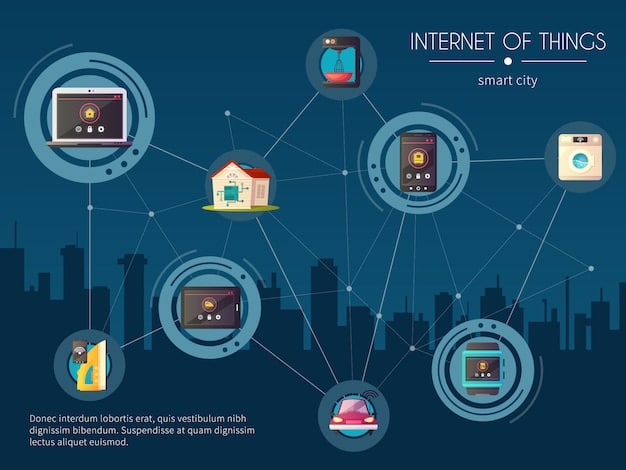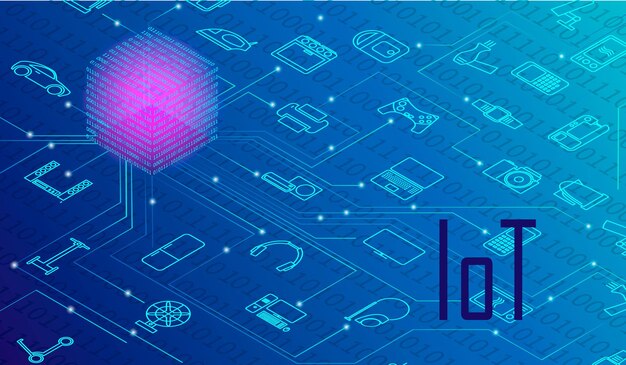Blockchain and IoT: Enhancing Security for Connected Devices in the US

Blockchain and the Internet of Things (IoT) integration offers enhanced security for connected devices in the US by providing decentralized, tamper-proof solutions that address vulnerabilities inherent in traditional IoT systems.
The convergence of Blockchain and the Internet of Things (IoT): Securing Connected Devices in the US is rapidly transforming digital security, offering innovative solutions to protect the expanding network of connected devices. This integration is particularly relevant within the US, where IoT adoption is widespread across various industries, making robust security measures essential.
Understanding the Intersection of Blockchain and IoT
The intersection of blockchain and IoT represents a powerful synergy, combining the strengths of both technologies to create more secure and efficient systems. This convergence aims to tackle the inherent vulnerabilities of traditional IoT infrastructures by leveraging the decentralized and immutable nature of blockchain.

In essence, integrating blockchain with IoT addresses critical concerns such as data integrity, device authentication, and secure communication, vital for maintaining trust and reliability within IoT ecosystems.
Key Benefits of Blockchain in IoT
Blockchain brings a number of advantages to IoT, improving security and offering new functionalities that traditional systems struggle to provide.
- Enhanced Security: By decentralizing data storage and employing cryptographic methods, blockchain makes it significantly harder for attackers to compromise data and connected devices.
- Improved Data Integrity: The immutability of blockchain ensures that once data is recorded, it cannot be altered, thereby maintaining data integrity and reducing the risk of manipulation.
- Simplified Device Management: Blockchain can streamline device registration, authentication, and updates, simplifying the management of large-scale IoT deployments.
- Increased Transparency: All transactions and data interactions are recorded on the blockchain, providing a transparent and auditable trail that fosters trust among stakeholders.
Ultimately, the blending of blockchain’s security features with IoT’s connectivity unlocks a more secure, verifiable, and transparent environment for a wide range of US industries.
Current IoT Security Challenges in the US
The rapid proliferation of IoT devices in the US presents significant security challenges. As more devices become interconnected, potential vulnerabilities and attack vectors increase, making it imperative to address these issues proactively.
Current IoT security measures often lag behind the sophistication of cyber threats, necessitating stronger, more adaptive security solutions.
Common Vulnerabilities in IoT Devices
Many IoT devices are plagued by common vulnerabilities that malicious actors can exploit.
- Weak Passwords: Default or easily guessable passwords remain a widespread issue, providing an easy entry point for attackers.
- Unsecured Communication: Many IoT devices transmit data without proper encryption, leaving the data vulnerable to interception.
- Lack of Regular Updates: Delayed or non-existent firmware updates can leave devices exposed to known vulnerabilities.
- Poor Device Authentication: Insufficient authentication mechanisms can allow unauthorized devices to access the network.
These vulnerabilities, combined with the increasing number of connected devices and the lack of standardized security protocols, pose a significant threat to the IoT ecosystem in the US.
How Blockchain Addresses IoT Vulnerabilities
Blockchain technology offers a robust solution to many of the security vulnerabilities inherent in IoT systems. By providing a decentralized and tamper-proof framework, blockchain can enhance the security and reliability of connected devices.
Blockchain’s core features—decentralization, immutability, and encryption—are ideally suited to address the challenges of securing IoT environments.

Decentralized Security
Decentralization ensures that no single point of failure exists, making it harder for attackers to compromise the entire system. This is achieved by distributing data and control across multiple nodes in the blockchain network.
Immutable Data Storage
The immutability of blockchain ensures that once data is recorded, it cannot be altered or deleted. This protects data integrity and provides an auditable trail of all transactions and device activities. This feature is especially useful for applications that require high levels of trust and accountability such as supply chain management or healthcare.
Secure Device Authentication
Blockchain can provide secure and reliable device authentication through the use of digital identities and cryptographic keys. This ensures that only authorized devices can participate in the network, mitigating the risk of unauthorized access and malicious activity.
Through these mechanisms, blockchain significantly reduces the attack surface and enhances the resilience of IoT systems, making them more resistant to cyber threats.
Use Cases of Blockchain for IoT Security in the US
The application of blockchain in IoT security is gaining traction across various sectors in the US, offering tangible benefits and addressing specific security challenges. Let’s explore some key sectors where blockchain integration is making a difference.
From healthcare to supply chain management, incorporating blockchain into IoT frameworks is revolutionizing operations and ensuring greater security.
Healthcare
In healthcare, protecting patient data and ensuring the integrity of medical devices are paramount. Blockchain can enhance security by:
- Providing secure storage and management of patient records.
- Verifying the authenticity of medical devices and preventing counterfeiting.
- Securing communication between medical devices and healthcare providers.
Supply Chain Management
Blockchain offers unparalleled transparency and security in supply chain management. Key benefits include:
- Tracking products from origin to delivery, ensuring authenticity and preventing fraud.
- Securing IoT-enabled sensors that monitor temperature, humidity, and other critical conditions during transit.
- Streamlining customs processes and reducing the risk of tampering.
Through these applications, blockchain enhances trust, efficiency, and security within critical US industries.
Challenges and Considerations for Implementation
While blockchain offers numerous benefits for IoT security, implementing this technology is not without its challenges.
Organizations need to carefully consider various factors to ensure successful integration and avoid potential pitfalls.
Scalability Issues
One of the main challenges is scalability. As the number of IoT devices increases, the blockchain network must be able to handle a high volume of transactions. Techniques such as sharding and off-chain solutions can help address this challenge.
Regulatory and Compliance Landscape
The regulatory landscape surrounding blockchain and IoT is constantly evolving. Businesses must stay informed about relevant regulations and ensure compliance with data protection laws, especially in the US.
Cost and Complexity
Implementing blockchain can be costly and complex, requiring specialized expertise and infrastructure. Organizations must conduct a thorough cost-benefit analysis and develop a clear implementation strategy.
Despite these challenges, the potential benefits of blockchain for IoT security make it a worthwhile investment for many US organizations.
The Future of Blockchain and IoT Security in the US
The future of blockchain and IoT security in the US looks promising. As both technologies continue to evolve, we can expect greater integration and innovation in this space.
With ongoing advancements, the synergy between blockchain and IoT is poised to reshape industries across the United States.
Emerging Trends
Several emerging trends are shaping the future of blockchain and IoT security:
- Edge Computing: Combining blockchain with edge computing can enable faster and more secure processing of IoT data at the edge of the network.
- AI Integration: Artificial intelligence can be used to analyze blockchain data and identify potential security threats.
- Standardization Efforts: Industry initiatives are working to develop standards and best practices for blockchain and IoT integration.
These trends indicate a continued push towards more secure, efficient, and user-friendly IoT ecosystems in the US.
| Key Point | Brief Description |
|---|---|
| 🛡️ Enhanced Security | Decentralization and encryption protect IoT devices from cyber threats. |
| 🔗 Data Integrity | Immutability ensures data cannot be altered, maintaining trust. |
| 🏭 Use Cases | Applications span healthcare, supply chain, and more. |
| 🚀 Future Trends | AI, edge computing, and standardization efforts are shaping the future. |
FAQ Section
▼
The primary advantage is enhanced security. Blockchain’s decentralized and tamper-proof nature protects IoT devices and data from cyber threats more effectively than traditional methods.
▼
Blockchain’s immutability means that once data is recorded, it can’t be altered. This ensures data integrity in IoT systems, making it vital for industries needing high trust and precise tracking.
▼
Several US industries, including healthcare and supply chain management, are adopting blockchain to improve IoT security, ensuring data protection and streamlined processes, particularly supply chain tracking.
▼
Key challenges include scalability issues, the evolving regulatory environment, and the initial cost and complexity of integrating blockchain into existing IoT infrastructures for US-based companies.
▼
Emerging trends include edge computing, AI integration, and standardization efforts aimed at creating more secure, efficient, and user-friendly IoT ecosystems across the United States, reducing vulnerabilities.
Conclusion
In conclusion, the combination of blockchain and IoT offers a promising path toward securing connected devices in the US. By addressing key vulnerabilities and providing a more secure and transparent framework, blockchain is set to play a crucial role in the future of IoT security.





